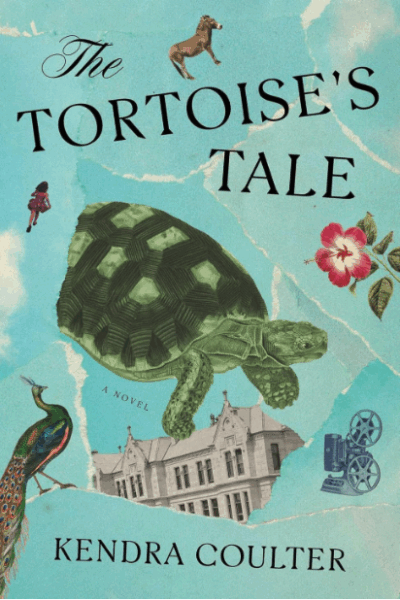Years ago, when I was in the Galápagos Islands, a fellow traveler asked how long tortoises live. Our guide’s answer was: “We don’t know.” No human has yet lived long enough to know for sure, though it’s estimated that tortoises can live well over two hundred years. It struck me then how incredible these animals are, and how very wise: We humans can’t come close to keeping up with them.
Kendra Coulter captures this sense of awe in her beautiful and engrossing novel, The Tortoise’s Tale. Inspired by Jonathan, a 192-year-old Seychelles Giant Tortoise, Coulter’s novel brings us into the world of a Galápagos tortoise who spends more than a century of her life as an exotic pet on a California estate, outliving human and animal companions as she observes life in all its forms: through music, politics, culture, family, and relationships.
While the narrator of The Tortoise’s Tale has many names, “Magic” is the one given to her by her beloved human friend and protector, a young girl named Lucy whose entire lifespan is witnessed by Magic. Magic remembers being cruelly snatched from her home and transported far away, though it’s not until near the end of the novel that she learns the extraordinary truth about her species, where she comes from, and just how old she is.
Meanwhile, Magic is part of a vast estate that sees many generations come and go, along with other captive animals that include a monkey, a peacock, donkeys, an alpaca, and others—some of whom are mercifully freed from their prisons along the way, while others remain behind bars or fences. Once, seeing towhees alighting on the cages of the captive birds, a young Magic reflects, “How people decided what to do and not do with animals, even those who were very similar, was a mystery.” As a highly sensitive individual, being attuned to others’ suffering starts to take its toll, but Magic learns how to manage: “I decided to feel the hurt of others not on top of me but rather behind me, propelling me forward.”
Magic, for the most part, is free to roam around the estate, and she is given her first name, Daisuke, by Takeo, the estate’s Japanese gardener—“the first time a person saw me and understood that I am someone.” As the decades pass, the jazz and big band music filling the grounds gives way to disco; Magic sees humans reflecting on the space race and communism, embracing the fashion trend of shoulder pads, and onward through the ages. And she constantly meets new generations as the estate passes from one family to another.
She is alternately tormented and respected; children, mostly boys, throw rocks, poke Magic with sticks, and use her carapace as a table. Lucy, throughout her life, is a steadfast friend to Magic and to all animals; she not only doesn’t eat meat during her 1950s childhood, she goes on to start up a plant-based food company after retiring from Hollywood. Her brother, Emmet, on the other hand, asks as a child: “What do people do with tortoises?”—reflecting the common human belief that all animals exist only to be of use to people. Lucy, on the other hand, is the first to treat Magic as her own being, the first to show her that this is even a possibility: “Affection. Kindness with no ulterior motive.”
Being so long lived, Magic is confronted with constant change and loss, as well as a devastating tragedy in Lucy’s family. Most stressful is the changing of the guard at the estate and what this means for Magic and all of the animals. “I began to contemplate the deeper implications of survival, in all its forms, and especially the vulnerability of being dependent on a singular other, a mortal human.”
This is one of the many insights brought to us by Magic, who evokes the lives of all animals who depend on humans for survival, from our companion animals to exotic species in captivity. At one point, when Emmet returns as the current heir to the estate, he seems “calmer and gentler,” “sweeter and lighter,” yet he brings with him more caged birds, showing that though people can change, often their attitudes toward animals do not, as Magic notices: “I stared at the cages and felt the weight of that lack of change.”
As time marches on, the estate becomes a hotel and eventually a healing center. When Lucy brings out a herpetologist—the first time in Magic’s life that she sees a “doctor”—the scientist discovers Magic’s past and just how special she really is. Not long afterward, Magic is finally brought a tortoise friend.
The Tortoise’s Tale gives us a glimpse into a rare and important species, as well as a snapshot of more than a century of human life, most notably how things change and how they do not, and the result is a novel that is thought-provoking, insightful, and ultimately hopeful. Despite the cruelty of her beginnings and her lifelong captivity, Magic embraces everything that her long life brings her, finding joy in music, fruits, and flowers; the animals she shares the estate with; and the humans who treat her like family. As time continues to move forward, as the California air grows dim with smoke, Magic moves into an uncertain future with a message for us all: “I am here, and hope lives in me.”

Midge Raymond is a co-founder of Ashland Creek Press. She is the author of the novels Floreana and My Last Continent, the award-winning short story collection Forgetting English, and, with John Yunker, the suspense novel Devils Island.

